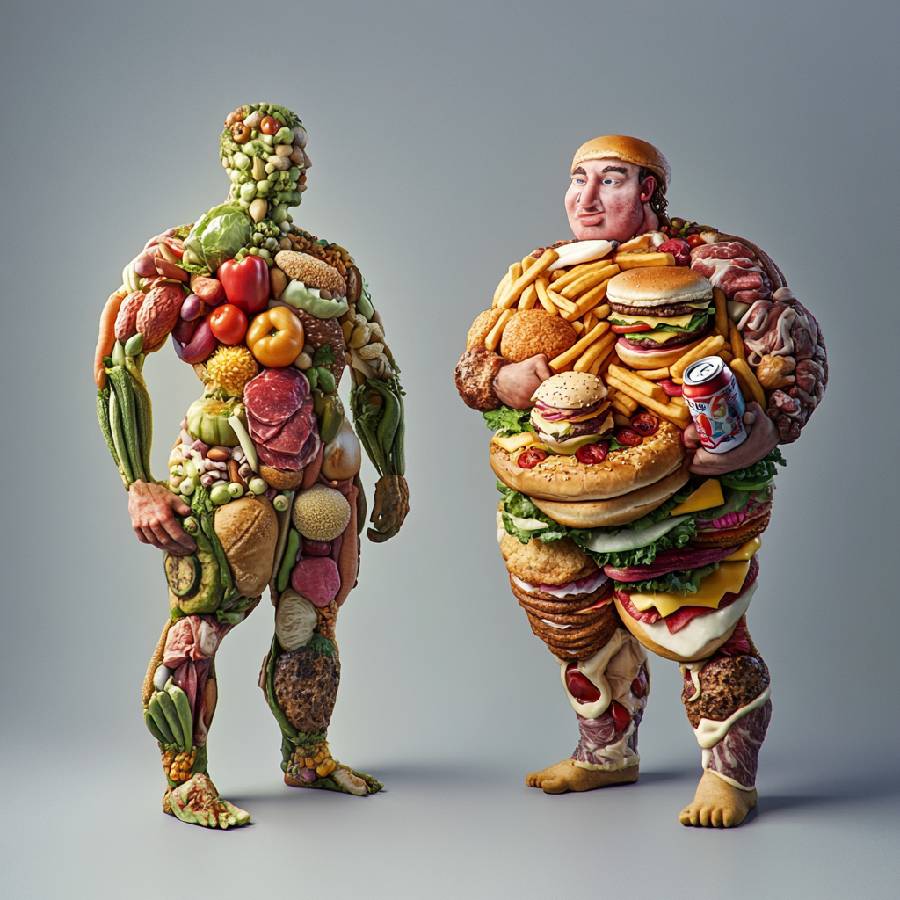The saying “You are what you eat” has never been more vividly depicted than in the striking image of two human figures made entirely of food. On the left, a figure sculpted from vibrant fruits, vegetables, lean meats, and whole foods stands tall and strong, symbolizing vitality, energy, and health. On the right, its counterpart—constructed from fast food, sugary drinks, and processed snacks—embodies the consequences of poor dietary choices, with a heavier, sluggish posture.
This stark contrast is more than artistic expression; it’s a powerful reminder of how our food choices shape our bodies, health, and overall well-being. Let’s break down the deeper meaning behind this imagery and how it relates to our daily lives.
The Left: The Power of Wholesome Nutrition
The figure on the left exudes strength, vitality, and balance. Made of fresh, nutrient-rich foods like broccoli, tomatoes, avocados, and lean cuts of meat, it showcases what happens when we fuel our bodies with what they need to thrive. These foods are rich in vitamins, minerals, antioxidants, and healthy fats that support:
- Energy and stamina: Whole foods provide steady energy by avoiding sugar crashes or the sluggishness caused by processed foods.
- Muscle growth and repair: Lean proteins and vegetables high in nutrients like potassium and magnesium help build a strong, functional body.
- Disease prevention: Diets rich in fruits and vegetables reduce the risk of chronic conditions like heart disease, diabetes, and certain cancers.
This figure represents balance and the beauty of a body fueled by clean, nourishing foods. It reminds us that what we eat today affects how we feel tomorrow.
The Right: The Toll of Unhealthy Choices
In stark contrast, the figure on the right reflects the health consequences of a diet dominated by fast food, sugary drinks, and processed snacks. Its bloated and unhealthy appearance symbolizes:
- Weight gain and obesity: A diet high in empty calories leads to excessive weight and its associated health risks.
- Chronic illnesses: Overconsumption of sugar, sodium, and unhealthy fats increases the likelihood of heart disease, diabetes, and high blood pressure.
- Low energy and mood swings: Processed foods often cause blood sugar spikes and crashes, leaving the body fatigued and irritable.
This figure serves as a cautionary tale of how indulging in convenience and comfort foods comes at a cost—both in physical health and quality of life.
The Connection Between Food and Self
The phrase “you are what you eat” highlights the profound connection between the food we consume and the bodies we inhabit. Every meal is an opportunity to nourish ourselves or to burden our bodies with foods that detract from our health. The image of these two figures makes that choice tangible, reminding us of the long-term effects our diets can have.
It’s important to note that the goal is not perfection but progress. Life happens, and indulgences are part of living fully—but the key is balance. Incorporating more whole, unprocessed foods into our diet and reducing reliance on fast and processed options can transform not just our bodies but also our energy, mood, and mindset.
A Call to Action
As you reflect on this powerful visual representation, ask yourself: What does your daily diet say about the person you want to become? The journey toward better health starts with small, intentional steps. Swap sugary drinks for water. Choose a side of vegetables over fries. Make your meals colorful with fruits and greens.
Ultimately, the foods you choose aren’t just about sustenance—they’re about shaping the life you want to lead. So, the next time you sit down for a meal, remember: you are what you eat, and your choices today will build your tomorrow.

Leave a Reply